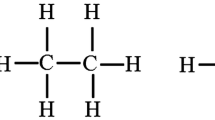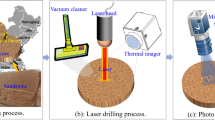Abstract
The results of theoretical and experimental studies of the effect of the microstructure of the pore space on the hydrophobization of oil and gas reservoirs are presented. A possible mechanism of formation of the microstructured wettability is described, which demonstrates that hydrophobization of the inner pore space in mixed wettability can be associated either with large or small pore sizes. It was proven experimentally that the process of hydrocarbon adsorption depended on the shape, size, and distribution of pores, the mineralogical composition (particle composition and size, presence of clay), as well as on the time of contact of hydrocarbons with the inner pore surface. The concept of the hydrophilic nature of rock prior to the migration of oil into it can be considered as accurate. However, as was shown in the experiments, oil could be present in the small pores (up to 10 μm), which was especially significant for the carbonate reservoirs.
Similar content being viewed by others
References
Al-Yousef, H.Y., Lichaa, P.M., Al-Kaabi, A.U., and Alpustun, H., Wettability evaluation of a carbonate reservoir rock from core to pore level, SPE Form. Eval., 1995, Pap. 29885, pp. 461–476.
Anderson, W.G., Wettability literature survey. Part 1. Rock/oil/brine interactions and the effects of core handling on wettability, JPT, 1986, pp. 1125–1144.
Brown, R.J.S. and Fatt, I., Measurements of fractional wettability of oilfield rocks by the nuclear magnetic relaxation method, Trans. AIME, 1956, vol. 207, pp. 262–264.
Kuzmin, V.A., The technique for studying the pore space of reservoir rocks using scanning electron microscopy in Tez. dokl. IV vsesoyuz. konf. “Kollektory nefti i gaza na bol’shikh glubinakh” (Proc. 4th All-Union Conf. on Collectors of Oil and Gas in Deep Subsurface), Moscow: Mosk. Inst. Nefti Gaza, 1987, pp. 196–197.
Kuzmin, V.A., Cathodoluminescence technique for studying the pore space of rocks using scanning electron microscopy, J. Surf. Invest.: X-Ray, Synchrotron Neutron Tech., 2007, vol. 1, no. 6, pp. 687–690.
Mikhailov, N.N., Dzhemesyuk, A.V., Kol’chitskaya, T.N., and Semenova, N.A., Izuchenie ostatochnogo neftenasyshcheniya razrabatyvaemykh plastov (Study of the Residual Oil Saturation of Developed Reservoirs), Moscow: VNIIOENG, 1990.
Mikhailov, N.N., Ostatochnoe neftenasyshchenie razrabatyvaemykh plastov (Residual Oil Saturation of Developed Reservoirs), Moscow: Nedra, 1992.
Mikhailov, N.N., Semenova, N.A., and Sechina, L.S., Mikrostrukturnaya smachivaemost’ i ee vliyanie na fil’tratsionno-emkostnye svoistva produktivnykh plastov (Microstructural Wettability and Its Effect on Reservoir Properties of Productive Formations), Moscow: Neftegaz Int., 2009, Iss. 1, pp. 8–11; Iss. 2, p. 5.
Mikhailov, N.N., Motorova, K.A., Sechina, L.S., and Gurbatova, I.P., Factors, affecting microstructural wettability of reservoir rocks in oil-and-gas deposits, in Mater. III Mezhd. nauchn. symp. “Teoriya i praktika primeneniya metodov uvelicheniya nefteotdachi plastov”. Tom 2 (Proc. III Int. Sci. Symp. “Theory and Practice of Enhanced Oil Recovery Methods), Moscow: OAO VNIIneft, 2011, vol. 2, pp. 108–113.
Mitchell, A.G., Hazell, L.B., and Webb, K.J., Wettability determination: pore surface analysis, in Proc. SPE Ann. Techn. Conf. Exhib., New Orleans, La, USA, 1990, pp. 351–360.
Radke, C.J., Kovscek, A.R., and Wong, H., A pore-level scenario for the development of mixed wettability in oil reservoirs, AlChe J., 1993, vol. 39, no. 6, pp. 1072–1085.
Robin, M. and Rosenberg, E., Fassi-Fihri, O., Wettability studies at the pore level: a new approach by use of cryo- SEM Michel, SPE Form. Eval., 1995, pp. 11–19.
Robin, M., Combes, R., Degreve, F., and Cuiec, L., Wettability of porous media from environmental scanning electron microscopy from model to reservoir rocks, SPE Form. Eval., 1997, no. 337235, pp. 251–256.
Sakhibgareev, R.S., Vtorichnye izmeneniya kollektorov v protsesse formirovaniya i razrusheniya neftyanykh zalezhei (Secondary Alterations of Reservoirs in the Process of Formation and Destruction of Oil Deposits), Leningrad: Nedra, 1989.
Salathiel, R.A., Oil recovery by surface film drainage in mixed wettability rocks, J. Pet. Technol., 1973, vol. 25, no. 10, pp. 1216–1224.
Semenova, N.A. and Sechina, L.S., The role of microstructural wettability in changing the filtration properties of productive formations, Vestn. TsKR Rosnedra, 2008, no. 2, pp. 44–49.
Wong, H., Morris, S., and Radke, C.J., Three-dimensional menisci in polygonal capillaries, J. Colloid Interface Sci., 1992, vol. 148, no. 2, pp. 317–336.
Author information
Authors and Affiliations
Corresponding author
Additional information
Original Russian Text © N.N. Mikhailov, V.A. Kuz’min, K.A. Motorova, L.S. Sechina, 2016, published in Vestnik Moskovskogo Universiteta, Seriya 4: Geologiya, 2016, No. 5, pp. 67–75.
About this article
Cite this article
Mikhailov, N.N., Kuz’min, V.A., Motorova, K.A. et al. The effect of the pore space microstructure on hydrophobization of oil and gas reservoirs. Moscow Univ. Geol. Bull. 71, 436–444 (2016). https://doi.org/10.3103/S0145875216060090
Received:
Published:
Issue Date:
DOI: https://doi.org/10.3103/S0145875216060090




